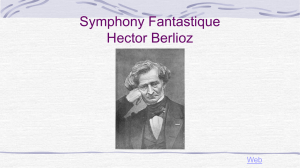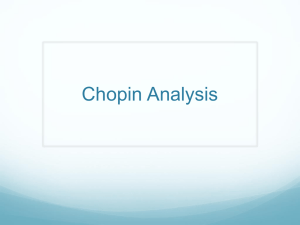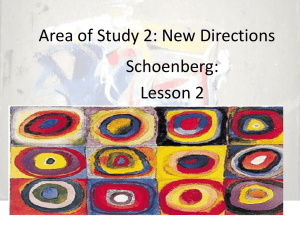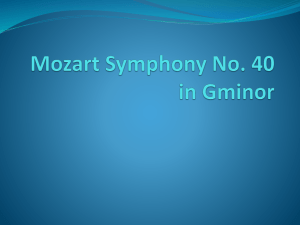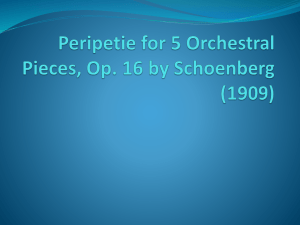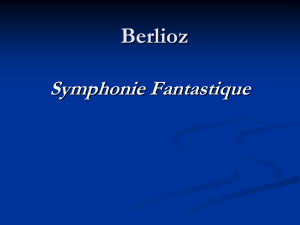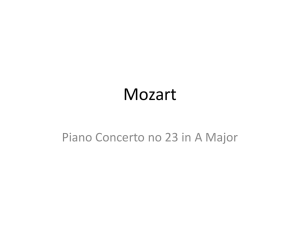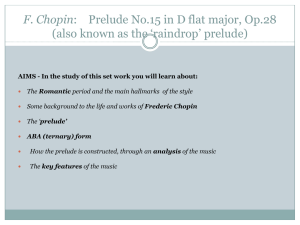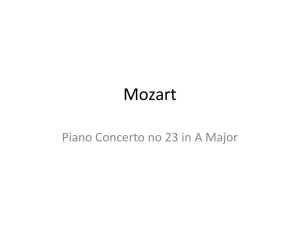Chopin – Prelude No.15 in Db major, Op.28
advertisement
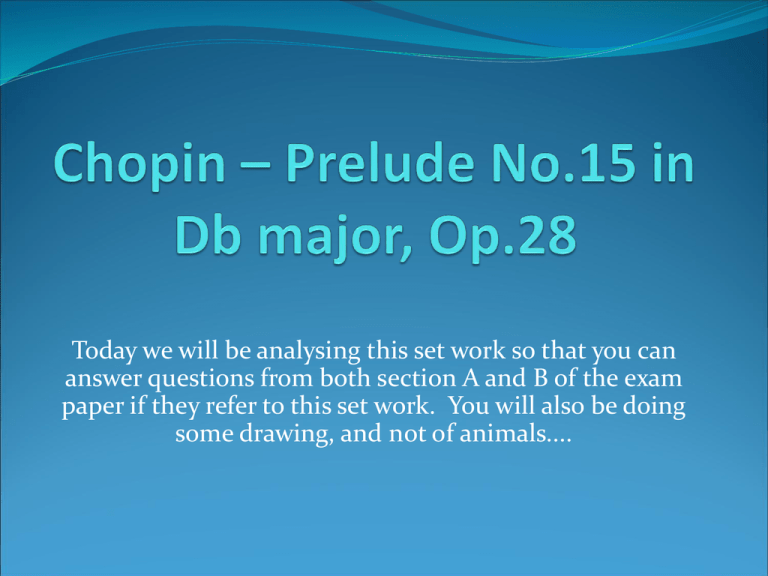
Today we will be analysing this set work so that you can answer questions from both section A and B of the exam paper if they refer to this set work. You will also be doing some drawing, and not of animals.... The Romantic Era (c.1830 – 1900) 1800’s = Age of Romanticism Music influenced by other art forms Expression of intense, but ordinary, human emotion i.e. Love, anger, grief, death, joy and the beauty of nature. Writers of the time = Byron, Shelley, Wordsworth Artists = Turner Composers = Dvorak, Mendelssohn, Tchaikovsky Features of the Romantic Style Emphasis on expressing a wide range of feelings and emotions Longer and more developed melody lines Freedom in use of form and structure Extended vocabulary of chords i.e. Dominant 13th Chromatic and discordant harmony to portray grief and anguish Strong and varied dynamics (pppp – ffff) Link to other arts through programme music Increased technical demand on performer and the rise of the virtuosic performer. Rise of Nationalism Significant expansion of the orchestra Development of the piano. The virtuoso performer Idea of struggle in the music led to the development of the ‘heroic’ soloist performer. Composers such as Brahms, Liszt and Chopin enjoyed writing music for themselves to perform. This piece is of moderate playing standard, and not virtuosic like other works by Chopin. It has a comparatively limited range and the rhythms are quite straight forward. Key techniques used include cantabile legato playing, careful expressive use of the pedals and use of rubato playing. The development of the piano Improved to give more power over a greater dynamic spectrum Became a supreme solo instrument Improvements were made by; Was reshaped and enlarged to create a bigger sound Number of notes increased to 7 octaves, increasing both bass and treble registers. Felt replaced leather on the hammers, producing a fuller, more rounded tone. Strings were longer, stronger. Increased tension meant the frame was now made of metal, not wood. Sustain and dampening pedals were developed. Chopin’s pianistic style Perfect example of the Romantic ideal being expressing the poetic feelings and emotions through sound. Chopin = Lonely, aloof, withdrawn. Talented but tragic, dying at 39yrs. Founder of the 19thC school of cantabile, or in the singing style – an emphasis on melodic lines. His compositional style; Long lyrical melodies with graceful ornamentation Spreading arpeggios Simple, broken chords with subtle pedalling Tempo rubato Passages of rapid articulation and virtuosic display Range of touch, tone quality and dynamics Background to the Preludes Op.28 Part of the group of works ‘The Preludes’, written between 1835-38 and published in 1839. Initially criticised for their lack of recognisable structure and brevity – The shortest being 13bars, longest is 90bars. Composed while Chopin was studying The WellTempered Clavier – A collection of preludes and fugues in each key. Chopin’s preludes are arranged in the circle of 5ths. Background to the Preludes Op.28 A Prelude = A brief opening piece to set a mood, linking to a fugue in the same key. Chopin’s preludes stand alone (no fugue following them) Each depicts a specific idea or emotion. Although all preludes, nocturnes and etude had titles in early editions, these were not given by the composers. Written during his period of recuperation at the deserted monastery in Valldemossa, Majorca. Written during a storm and depict the raindrops from the roof of the monastery. (Ab’s in section A, G#’s in section B). These pedal notes pervade the work but do not detract from the beauty of the melody line. The form and structure Loosely ternary form Even though over half of the piece is section B, which is dark and stormy in mood, the piece is remembered for it’s beautiful elegiac melody of section A. Section Key Length A (Bars 1-27) Db Major 27 bars B (Bars 28-75) C# Minor (Tonic Minor) 47 Bars A (Bars 75-81) Db Major 6 Bars Codetta (Bars 81-89) Db Major 8 Bars Section A: Bars 1-4 Main motif = ‘Falling’ motif. A Sighing figure, commonly used in music since Renaissance times to represent sadness, melancholy and grief. Fills in the phrase with stepwise movement upwards to Gb and then back down again to Db. Inner parts provide harmonic support, doubling in 6th at bars 2-4. Harmony is diatonic using mainly chords I and V7. Bar 4b = Ic-V7-I followed by septuplet figure made up of an acciaccatura figure followed by a turn. Bars 5-12 Bars 5-8 = Repeat of Bars 1-4 Bar 8 (Beat 1 -12) = New, second part of the theme is heard. Variation every 4 bars. Simple stepwise melody. Odd chromatic note seen (i.e. Cb in bars 9 and 11) used to add colour to the harmony. G in bar is more impotant, hinting at Ab Major (Dominant key) Bar11-12 = V-I cadence Notice the turns in bars 11 and 15. Bars 28-35 2, 4-bar phrases Chorale-like crotchet melody in the left hand Octave G#’s in the right hand (similar to the Ab’s permeating the left hand of section A) Bars 36-39 Repetition of bars 28-31 except the right hand has inner crotchet movement, doubling the left hand in octaves This produces a thicker texture and reinforces the melody as we crescendo to ff at bar 40. Bars 40-43 Sombre mood is broken by dramatic E major chord In G# minor for 4 bars (relation to C# minor and Ab from section A?!) Created by using the ambiguous chord in Bar 39 (with no 3rd – Like a power chord) as a G# minor chord. V-I cadence in G# minor in bars 42-43. Strong and powerful section of music achieved through octaves, use of minims and accents on each note. The texture is the reduced to single p quaver G#s ready for a repeat of the whole section so far. Bars 44 - 59 This is a repeat of bars 28 – 43. The only differences are slight dynamic changes and the repeated G#s are an octave higher. Bars 60-63 Back in C# minor. Melody moves to the top of the texture Chorale-like and step wise movement. Melody is similar to the first part of section B i.e. Bars 30-31, but this time augmented. Repeated G# quavers are in the centre of the texture Bars 64-67 Static harmony chords of V and I in C#min, forming a series of perfect cadences Repeated quaver and minim G#’s form a pedal effect. G# is the dominant, therefore it is a dominant pedal. As the G#’s are on the top of the texture, it is an inverted dominant pedal. If the G#’s were on the bottom, it would just be a pedal, if it was in the middle of the texture, it would be an inner pedal. Bars 68-70 A repeat of bars 60-62 And that is all. Golden Doodles are most awesome. Bars 71-74 A forte passage. F# minor (bar 71) and then back to C# minor (bar 72) Added A# are chromatic notes in C# minor, making it an added sixth chord. As we hover on G#, there is a feeling of anticipation as we prepare to modulate back to the home key of Db major, returning to the A section. Bar 75 This is a link bar, back to the opening A section G# - E# - F# -D# can be read as Ab – F – Gb – Eb. Section A reprise Bars 76-79 A 4-bar reprise of the opening 4 bars The ornament figure is extended to a 10 note figure (Dectuplet, rather than a septuplet!) Smorzando (bar 79) = Dying away. Bars 80-81 A ‘broken off’ repeat of the opening figure. Meant to be dream-like fading away into a mini cadenza in bars 81-83. Slentando = gradually slower. Bars 81, beat 4 - 83 The forte top Bb (highest note in the piece) grabs the listener’s attention. This 2-bar phrase descends in dynamic and pitch leading to the final 6-bars of the piece. Bars 84-89 6-bar phrase based on the tonic and dominant in Db major Ab’s heard in the middle of the texture (left hand) Melodic line is in the middle of the texture (right hand), resembling the minor melody heard in bars 60-62. Piece ends pp with a V-I cadence in bars 87-88. A ritenuto bar of tonic harmony leads to the final chord in bar 89. Define the following... Chorale Forte Repetition Chromatic Augmented Modulate Ritenuto Reprise Pedal Ornament Static Harmony Smorzando Inverted Pedal Cadenza GoldenDoodle Slentando Inner Pedal Now, answer the questions on Page 45 of the text book. Work Hard, Chopin is always watching you..... Essay-style Question for Section B 1: In what year was this piece composed? (1 mark) 2: Where did Chopin compose the piece? (1 mark) 3: Under the following headings discuss the main features of the piece I am watching Structure you work....... Ornamentation Harmony Italian score markings (10 marks) ART-TASTICNESS! Today’s challenge is to...... Demonstrate the 3 types of pedal using the analogy of a sandwich
